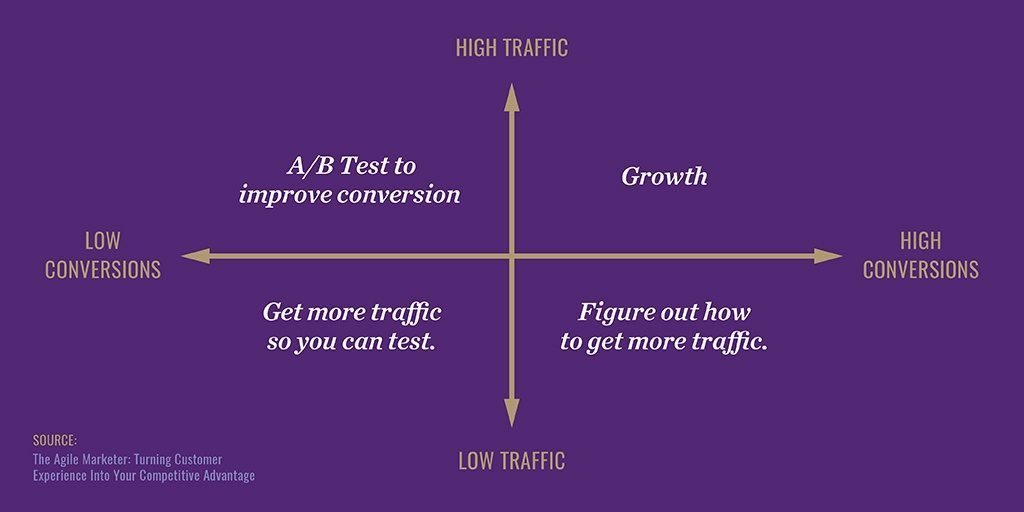Everyone seems to have strong opinions about A/B testing. When done correctly, A/B testing feels like a cheat code that just lifted conversions, increased revenue, and made you look really smart. At its worst, A/B testing is nagging your designer to make the discount text a little bigger and move it to the right a little bit.
Whatever your opinions, understanding when you should and shouldn’t test will determine your overall success with A/B testing. Below are a few ways to convince key stakeholders within your organization to invest in A/B testing, as well as instances when you should probably focus your marketing efforts elsewhere.
What’s So Great About A/B Testing?
Despite how many blog posts you’ve shared with leadership, maybe you haven’t gotten them to fully buy into A/B testing just yet. Perhaps they’re too busy, or they simply don’t want to spend money on testing software such as Optimizely or VWO in addition to the numerous other SaaS products they already pay for (it’s understandable, really).
You’re going to have to sell them. It might not be easy, but lucky for you, we’ve put together a few quick and easy examples of A/B testing benefits we’ve experienced firsthand.
A/B Testing Drives Revenue
As marketers, we joke about overusing terms and acronyms like ROI. But when it comes to optimization, the ROI potential from even a small lift in conversion is insane.
Granted, not every test will be successful. But if you’re able to increase conversions by 10%, depending on the amount of traffic the page receives, that increase has the potential to drive a lot of additional revenue at a very low cost. You’d be surprised at how adjusting a few CTAs can affect the bottom line and overall leads when tested strategically.
Test to Gauge Larger Projects
Getting ready to launch a big campaign? Consider testing first.
Before you invest tons of time, energy, and money, experiment with certain elements to help determine if there is potential in that area. Using this approach when making bigger decisions can help eliminate some of the risk, increase revenue, and save costs. All good things.
You’ll Get the Most Out of Your Content
If you already have good pieces of content (even better if you know that content converts well), why not direct more qualified traffic to it? For example, let’s say you create an awesome case study that’s been driving leads that convert at a higher than average rate. The only problem is you don’t get a lot of traffic to the case study. By testing ways to increase traffic to the study – through A/B testing things like CTAs, page design, or actionable copy – you can bring in more quality leads through resources you’ve already created.
In short, A/B testing allows you to get the most bang for your buck.
A/B Testing Can Clear Up Customer Life Cycle Confusion
Picture this: your team creates a landing page that’s meant to target bottom-of-the-funnel leads, except you find that it’s not converting. After doing a little bit of keyword research, you hypothesize that the reason it’s not doing well is because the traffic hitting the page is likely made up of top-of-the-funnel leads who aren’t ready to commit.
In this scenario, you could suggest A/B testing verbiage on the page that is optimized toward different customer lifecycles to help determine which part of the funnel these customers are in. This not only helps you understand your customers’ buyers journey, but also gives you insight as to why customers might not be converting at a higher rate.
When You Shouldn’t Be A/B Testing
As the growth mindset has infiltrated marketing departments big and small, you might be dealing with leadership pressuring your team to test, test, test! Although we appreciate the excitement, there are circumstances in which running an A/B test should not be a priority.
Below are just a few instances when you may not actually be ready to test.
There’s Not Enough Traffic
To run a successful test and determine a winner, you need a decent amount of traffic. So, if your site is lacking traffic, work on that first. A great visual example of this is depicted on a graph from The Agile Marketer: Turning Customer Experience Into Your Competitive Advantage.
Key takeaway: traffic first, optimize second.
You Haven’t Defined Conversion Points
A/B testing relies on some sort of measurable conversion point. If you don’t have these metrics in place, there’s no way to determine the success of a test. And don’t start making up conversion points just because you need them – these should trickle down from your company’s larger overall business goals.
You Haven’t Created a Testing Plan
Testing and optimization is a science. Ideas need to be prioritized based on things like potential impact, ease of implementation, and how likely the test is to succeed. From there, you’ll need to determine the length of the test, how you’ll implement it, how long it will run, and how you’ll share and execute on the data gathered from the experiment.
Remember, testing just to test will get you nowhere. While the primary the purpose of optimization is to increase revenue, leads, etc., you’ll only get there if you’re gathering meaningful data. If you don’t have a testing plan, make sure to sort that out first.
To Test or Not To Test? This One’s on You
We would all like to increase the conversion rate across our sites. That part is obvious. But while executing A/B tests can definitely help you convert more leads into customers, it’s important to do things the right way, and not to test for the sake of testing. If you have all the moving pieces in place – such as success metrics, a good chunk of traffic, and a testing plan – then yes, you should probably be A/B testing. If not, focus your energy on those things first.
For a deeper dive into E3’s optimization work, check out our work for Airstream.
Once you’ve got a strong A/B testing strategy in place, check out this awesome guest post by CRO expert Lars Lofgren on his 7-step A/B testing strategy for double or triple your conversion rates – a strategy we use in our A/B testing at E3.






